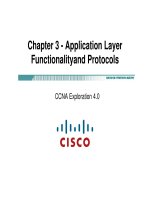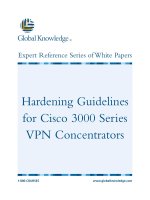Cisco CCNA exploration v 4_1 pptx
Bạn đang xem bản rút gọn của tài liệu. Xem và tải ngay bản đầy đủ của tài liệu tại đây (1.21 MB, 40 trang )
Cisco CCNA exploration v 4.0, module 2, Final exam.
1.
Refer to the exhibit. R1 knows two routes, Path A and Path B, to the Ethernet network attached to R3. R1 learned Path A to network 10.2.0.0/16 from a static route and Path B to network 10.2.0.0/16 from EIGRP. Which route will R1 install in its
routing table?
Both routes are installed and load balancing occurs across both paths.
The route via Path B is installed because the EIGRP route has the best metric to network 10.2.0.0/16.
The route via Path A is installed because the static route has the best metric to network 10.2.0.0/16.
The route via Path B is installed because the EIGRP route has the lowest administrative distance to network 10.2.0.0/16.
The route via Path A is installed because the static route has the lowest administrative distance to network 10.2.0.0/16.
2.
Refer to the exhibit. The network has three connected routers: R1, R2, and R3. The routes of all three routers are displayed. All routers are operational and pings are not blocked on this
network.
Which ping will fail?
from R1 to 172.16.1.1
from R1 to 192.168.3.1
from R2 to 192.168.1.1
from R2 to 192.168.3.1
3. What are two functions of a router? (Choose two.)
It connects multiple IP networks.
It controls the flow of data via the use of Layer 2 addresses.
It determines the best path to send packets.
It manages the VLAN database.
It increases the size of the broadcast domain
4. Which two statements are true regarding link-state routing protocols? (Choose two.)
They are aware of the complete network topology.
They offer rapid convergence times in large networks.
They do not include subnet masks in their routing updates.
They rely on decreasing hop counts to determine the best path.
They do not work well in networks that require special hierarchical designs.
They pass their entire routing tables to their directly connected neighbors only.
W
h
i
c
h
t
w
o
s
t
a
t
e
m
e
n
t
s
a
r
e
c
o
r
r
e
c
t
a
b
o
u
t
t
h
e
s
p
l
i
t
h
o
r
i
z
o
n
w
i
t
h
p
o
i
s
o
n
r
e
v
e
r
s
e
m
e
t
h
o
d
o
f
r
o
u
t
i
n
g
l
o
o
p
p
r
e
v
e
n
t
i
o
n
?
(
C
h
o
o
s
e
t
w
o
.
)
I
t
i
s
e
n
a
b
l
e
d
b
y
d
e
f
a
u
l
t
o
n
a
l
l
C
i
s
c
o
I
O
S
i
m
p
l
e
m
e
n
t
a
t
i
o
n
s
.
I
t
a
s
s
i
g
n
s
a
v
a
l
u
e
t
h
a
t
r
e
p
r
e
s
e
n
t
s
a
n
i
n
f
i
n
i
t
e
m
e
t
r
i
c
t
o
t
h
e
p
o
i
s
o
n
e
d
r
o
u
t
e
.
I
t
s
e
n
d
s
b
a
c
k
t
h
e
p
o
i
s
o
n
e
d
r
o
u
t
e
u
p
d
a
t
e
t
o
t
h
e
s
a
m
e
i
n
t
e
r
f
a
c
e
f
r
o
m
w
h
e
r
e
i
t
w
a
s
r
e
c
e
i
v
e
d
.
I
t
i
n
s
t
r
u
c
t
s
r
o
u
t
e
r
s
t
o
h
o
l
d
a
l
l
c
h
a
n
g
e
s
t
h
a
t
m
i
g
h
t
a
f
f
e
c
t
r
o
u
t
e
s
,
f
o
r
a
s
p
e
c
i
f
i
e
d
p
e
r
i
o
d
o
f
t
i
m
e
.
I
t
l
i
m
i
t
s
t
h
e
n
u
m
b
e
r
o
f
h
o
p
s
a
p
a
c
k
e
t
c
a
n
t
r
a
v
e
r
s
e
t
h
r
o
u
g
h
t
h
e
n
e
t
w
o
r
k
b
e
f
o
r
e
i
t
i
s
d
i
s
c
a
r
d
e
d
.
6
.
Refer to the exhibit.
Which router is advertising subnet 172.16.1.32/28?
Router1
Router2
Router3
Router4
7.
Refer to the exhibit.
All router interfaces are configured with an IP address and are operational. If no routing protocols or static routes are configured, what information will be included in the show ip route command output for router A?
All of the 192.168.x.0 networks will be in the routing table.
Routes to networks 192.168.1.0/24, 192.168.2.0/24, and 192.168.3.0/24 will be in the routing table.
The routing table will be empty because routes and dynamic routes have not been configured.
A default route is automatically installed in the routing table to allow connectivity between the networks.
8. When a router boots, what is the default order to locate the Cisco IOS if there is no boot system command?
ROM, TFTP server, flash
flash, TFTP server, ROM
flash, NVRAM, TFTP server
NVRAM, TFTP server, flash
9. Which router component is used to store the routing table?
Flash
NVRAM
ROM
SDRAM
10. Which three statements describe the operation of routing with EIGRP? (Choose three.)
As new neighbors are discovered, entries are placed in a neighbor table.
If the feasible successor has a higher advertised cost than the current successor route, then it becomes the primary route.
If hello packets are not received within the hold time, DUAL must recalculate the topology.
The reported distance is the distance to a destination as advertised by a neighbor.
EIGRP maintains full knowledge of the network topology in the topology table and exchanges full routing information with neighboring routers in every update.
EIGRP builds one routing table that contains routes for all configured routed protocols.
11. What two routing protocols use a hierarchal network topology? (Choose two.)
IS-IS
EIGRP
OSPF
RIPv1
RIPv2
12.
Refer to the exhibit.All routers are running RIPv1. The two networks 10.1.1.0/29 and 10.1.1.16/29 are unable to access each other. What can be the cause of this problem?
Because RIPv1 is a classless protocol, it does not support this access.
RIPv1 does not support discontiguous networks.
RIPv1 does not support load balancing.
RIPv1 does not support automatic summarization.
13. What command would the network administrator apply to a router that is running OSPF to advertise the entire range of addresses included in 172.16.0.0/19 in area 0?
R1(config-router)# network 172.16.0.0 0.0.0.255 area 0
R1(config-router)# network 172.16.0.0 0.0.3.255 area 0
R1(config-router)# network 172.16.0.0 0.0.15.255 area 0
R1(config-router)# network 172.16.0.0 0.0.31.255 area 0
14.
Refer to the exhibit. Which statement is true concerning the routing configuration?
Using dynamic routing instead of static routing would have required fewer configuration steps.
The 10.1.1.0/24 and 10.1.2.0/24 routes have adjacent boundaries and should be summarized.
Packets routed to the R2 Fast Ethernet interface require two routing table lookups.
The static route will not work correctly.
15.
Refer to the exhibit. A network administrator has enabled RIP on routers B and C in the network diagram. Which of the following commands will prevent RIP updates from being sent to Router
A?
A(config)# router rip
A(config-router)# passive-interface S0/0
B(config)# router rip
B(config-router)# network 192.168.25.48
B(config-router)# network 192.168.25.64
A(config)# router rip
A(config-router)# no network 192.168.25.32
B(config)# router rip
B(config-router)# passive-interface S0/0
A(config)# no router rip
16.
Refer to the exhibit. What information can be determined from the highlighted output?
R1 is originating the route 172.30.200.32/28.
Automatic summarization is disabled.
The 172.30.200.16/28 network is one hop away from R1.
A classful routing protocol is being used.
17.
Refer to the exhibit. Given the topology shown in the exhibit, what three commands are needed to configure EIGRP on the Paris router?
(Choose three.)
Paris(config)# router eigrp 100
Paris(config)# router eigrp
Paris(config-router)# network 192.168.6.0
Paris(config-router)# network 192.168.7.0
Paris(config-router)# network 192.168.8.0
Paris(config-router)# network 192.168.9.0
18. A network administrator needs to assign the very last usable IP address in the 172.24.64.0/18 network range to the router interface that serves this LAN. Which IP address should the administrator configure on the interface?
172.16.128.154/18
172.16.255.254/18
172.24.64.254/18
172.24.127.254/18
19.
Refer to the exhibit. Based on the output from the show running-config and debug ip rip commands, what are two of the routes that are added to the routing table of R1? (Choose two.)
R 192.168.1.0/24 [120/1] via 172.16.2.1, 00:00:24, Serial0/0/1
R 192.168.100.0/24 [120/1] via 172.16.1.1, 00:00:24, Serial0/0/0
S 192.168.1.0/24 [1/0] via FastEthernet0/0
R 192.168.9.0/24 [120/1] via 172.16.2.1, 00:00:24, Serial0/0/0
R 192.168.2.0/24 [120/1] via 172.16.1.2, 00:00:24, Serial0/0/0
20.
Refer to the exhibit.
The show cdp neighbors command was run at R1. Which two facts about the newly detected device can be determined from the output? (Choose two.)
ABCD is a router that is connected to R1.
ABCD is a non-CISCO device that is connected to R1.
The device is connected at the Serial0/0/1 interface of R1.
R1 is connected at the S0/0/1 interface of device ABCD.
ABCD does not support switching capability.
21. A network is configured with the IP, IPX, and AppleTalk protocols. Which routing protocol is recommended for this network?
RIPv1
RIPv2
EIGRP
OSPF
22.
Refer to the exhibit.
The network administrator is planning IP addressing of a new network. What part of this addressing scheme must be changed to allow communication between host A and the server?
the IP address of the server
the default gateway of host A
the IP address of host A
the default gateway of the server
23.
Refer to the exhibit. Two routers are unable to establish an adjacency. What is the possible cause for this?
The two routers are connected on a multiaccess network.
The hello and dead intervals are different on the two routers.
They have different OSPF router IDs.
They have different process IDs.
R
e
f
e
r
t
o
t
h
e
e
x
hi
bi
t.
B
o
t
h
r
o
u
t
e
r
s
a
r
e
u
si
n
g
t
h
e
R
I
P
p
r
o
t
o
c
ol
.
D
e
vi
c
e
s
o
n
t
h
e
1
9
2
.
1
6
8
.
1
.
1
n
e
t
w
o
r
k
c
a
n
pi
n
g
t
h
e
S
0
/
0
/
0
in
t
e
rf
a
c
e
o
n
R
2
b
u
t
c
a
n
n
o
t
pi
n
g
d
e
vi
c
e
s
o
n
t
h
e
1
9
2
.
1
6
8
.
2
.
1
n
e
t
w
o
r
k.
W
h
a
t
is
a
p
o
s
si
bl
e
c
a
u
s
e
o
f
t
hi
s
p
r
o
bl
e
m
?
T
h
e
r
o
u
t
e
r
s
a
r
e
c
o









